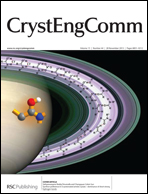Divalent copper trans-1,4-cyclohexanedicarboxylate coordination polymers with isomeric dipyridylamide ligands: new pillared and self-penetrated binodal networks†
Abstract
Hydrothermal synthesis has afforded a pair of divalent copper coordination polymers containing trans-1,4-cyclohexanedicarboxylate (t-14cdc) and one of two isomeric dipyridylamides, 3-pyridylnicotinamide (3-pna) or 3-pyridylisonicotinamide (3-pina). Both of these materials feature unprecedented 3-D topologies. [Cu(t-14cdc)(3-pna)]n (1) manifests [Cu(t-14cdc)]n 4·82 layers featuring embedded anti–syn axial–equatorial bridged [Cu(OCO)]n chain motifs, pillared by anti-conformation 3-pna ligands into a new yet very simple binodal 3,5-connected (4·6·8)(4·66·83) network topology. {[Cu2(t-14cdc)2(3-pina)2(H2O)]·5H2O}n (2) shows two different copper/t14cdc chain motifs with isolated copper ions and {Cu2O2} dimeric units, respectively. These are linked together by 3-pina ligands to afford a new self-penetrated 4,6-connected binodal net with (4·64·8)2(42·612·8) topology. Variable temperature magnetic susceptibility experiments reveal very weak ferromagnetism (g = 2.01(1), J = 0.04(1) cm−1) along the [Cu(OCO)]n chains in 1 and weak antiferromagnetism (g = 1.906(3), J = −3.4(3) cm−1) within the {Cu2O2} dimeric units in 2. Thermal properties are also presented.


 Please wait while we load your content...
Please wait while we load your content...